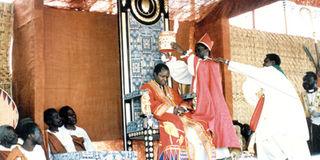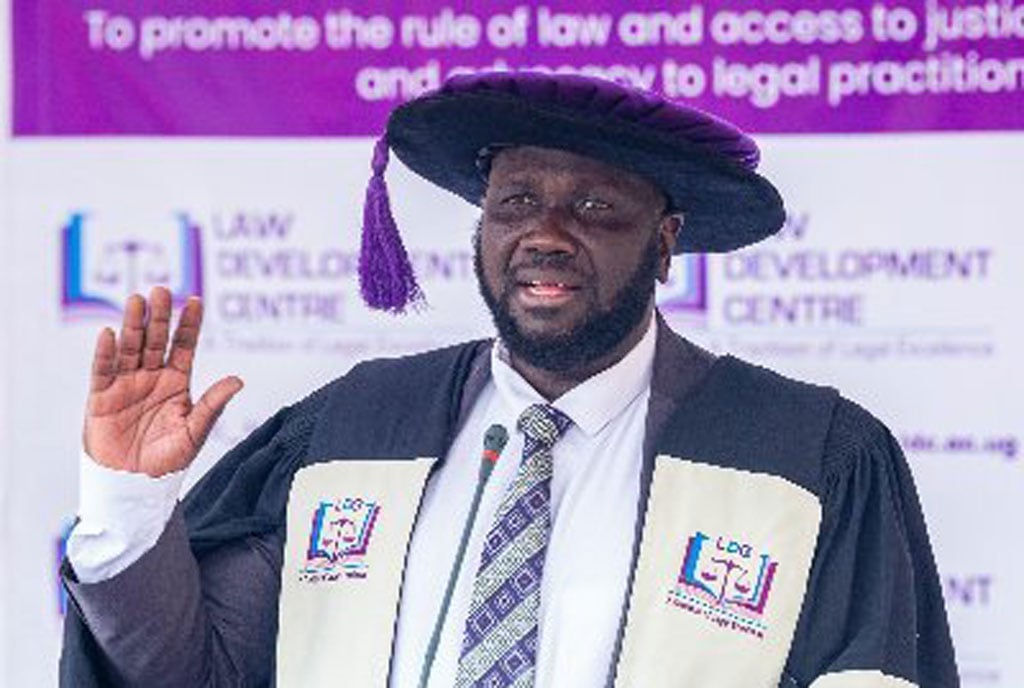Prime
The coronation of Kabaka Ronald Muwenda Mutebi II

Then kingdoms were restored in 1993 and for the first time in 27 years, people of Buganda were proud to say there was a king on the throne. PHOTO/FILE
What you need to know:
- 27 years since kingdoms were banned. In 1993, Prince Ronald Muwenda Mutebi became the Kabaka after a coronation at Naggalabi. Different people who attended the celebrations recount their experience.
- The crown. When monarchs and kingdoms were banned by President Milton Obote, for many, this was the end of something they held dear.
- Then kingdoms were restored in 1993 and for the first time in 27 years, people of Buganda were proud to say there was a king on the throne.
“Nothing prepared me for what I saw at Naggalabi because I had never witnessed a coronation before. While I was aware that the people of Buganda were deeply attached to the heritage to which the Kabaka is the custodian, nothing prepared me for the crowds. I had never seen such a large crowd before,” recalls Charles Peter Mayiga, the Katikkiro (prime minister) of Buganda Kingdom.
He was part of the central organising committee of the coronation of Ronald Edward Frederick Kimera Muwenda Mutebi II, the 36th King of Buganda Kingdom, a traditional monarchy in central Uganda.
Artist Nuwa Wamala Nnyanzi, the then minister of internal affairs of the kingdom, says that they had pondered the idea of screening people but later on dropped the idea as crowds grew to mammoth level.
“We spent a night in one of the classrooms at King’s College Budo in order to be early to report on the event. I couldn’t believe the massive turnout. Even Brigadier (his army rank at the time) Ivan Koreta, who headed the security detail, felt overwhelmed,” Geoffrey Ssenoga, a journalist with Uganda Television (UTV), recounts about the euphoric event.
Some 300 local and international media houses were invited for coverage of the event. The coronation was also graced by delegations from Eswatini Kingdom as well as those sent in by Egyptian president, Hosni Mubarak, Palestinian leader Yasser Arafat, Kenya’s Daniel Arap Moi, friends of Ssekabaka Sir Edward Frederick William David Walugembe Mutebi Luwangula Mutesa II from England and President Yoweri Kaguta Museveni in company of the First Lady, Janet Museveni.

Katikiro Charles Peter Mayiga. PHOTO/EDGAR R BATTE
In attendance was Kabaka Ronald Mutebi’s guardian, Captain Ronnie Owen, and Richard Carr-Gomm, local and regional religious leaders, government officials among other dignitaries and locals who constituted the larger part of the gathering at Naggalabi in Budo.
Here comes the king
Adorned in a maroon robe, his grandfathers’ medals and royal regalia, the main celebrant of the day appeared calm and quite happy at the sight of the many people. From his body language, Katikkiro Mayiga read more. “He looked deep in thought, right from the time he emerged from Buganda House. He could occasionally smile. I think, finally the burden of being head of the kingdom ushered on his shoulders. Again, you could see that he was happy because the people he led were happy,” he recollects.
Nnyanzi was on edge, his eyes on the king to make sure he was secure in the face of the multitudes. Through his camera lenses and his bare eyes, television journalist Ssenoga saw a calm Kabaka. “He was so relaxed, with no panic. He had lived through this. It was people around him who were panicking and bickering. The majesty of the occasion was overwhelming,” he adds. Mayiga adds that up until that point in his life, he had never seen people so happy, with sheer joy and a look of contentedness on their faces. The crowd consisted of people of all classes; the ordinary people who were the vast majority and then the VIPs; royals, religious and clan heads.
The Naggalabi coronation rite was the second Kabaka Mutebi was going through. As Nnyanzi and Ssenoga add, he had gone through the traditional ceremony in 1972 at the Bamunanika Palace.
In his published series, one titled ‘Ssabataka Ronald Mutebi’, Timothy Ntanda Lukabi writes that when the body of Ssekabaka Mutesa was returned, Mutebi was enthroned by then Katikkiro Joash Mayanja Nkangi and Mayanja Mugema and clan leaders at a ceremony attended by among others, Kenya’s vice president (VP) Daniel Arap Moi, Archbishop of Kampala, Emmanuel Cardinal Nsubuga and the Rt Reverend Dunstan Nsubuga.

Artist Nuwa Wamala Nnyanzi during the interview. PHOTO/ADGAR R BATTE
Return of kingdoms
The coronation ceremony was repeated on July 31, 1993, 27 years after the kingdom had been abolished by former president and Uganda People’s Congress frontman Milton Obote.
The restoration of a traditional leader called for celebration. As such, a lot of preparation went into what culminated in the coronation of Kabaka Mutebi.
There were a number of meetings and negotiations between monarchy officials and enthusiasts and the government which led to amendment of the constitution. A night before D-day, there was preparation for events the next day. Members of the central organising committee spent the night at Naggalabi along with the king.
“It was the first time for me to share the same roof with the Kabaka in Enyumba Buganda- the big hut- in Naggalabi,” Nnyanzi recounts. Close to the break of dawn, at about 5am, the Kabaka started the day with traditional ceremonies, the first one being a mock fight with the keeper of Naggalabi dubbed ‘Olutalo Lwebirumbirumbi’.
“After the mock fight, he went to Bwanika house where his wounds are supposed to be nursed. In the past, they were real fights. Now they are mock fights to commemorate what was experienced in the past. In Bwanika House, he was dressed in fresh bark cloth and animal skin because the ones he wore in the fight have been stained with blood and sweat as well as getting torn,” the Katikkiro narrates.
However, President Museveni had arrived early and as Nnyanzi recalls, when they got to Nyumba Bwanika, the president had arrived and needed to be evacuated so that the Kabaka could enter.
The rituals
Inside, ‘Bwanika’, is the Kabaka’s Namulondo (throne). A number of rituals are performed within the house before he proceeds to the area of coronation called ‘Nakibuuka’.
In his paper, Obwakabaka Bwa Buganda- the Coronation Lecturer, Prof Semakula Kiwanuka observes that traditionally (since 1914), there are three types of thrones: The first one at ‘Nakibuuka’, is actually a mound.
“The Kabaka ascends it and while standing on it, he recites, ‘I am king. With the help of God, I shall live longer than my ancestors. I shall rule the nations and shall put down rebellion’. The second is the real Nnamulondo. There has always been a traditional throne upon which the Kabaka sat,” he writes, in part.
According to tradition, prof Kiwanuka writes on, the surviving throne began with Kabaka Mulondo who succeeded his slain father as a baby. Mulondo’s clan (Butiko) made a chair for him to sit on and this became the throne of the Kabakas of Buganda ever since. It is called Nnamulondo.
He adds, “The third and modern throne was originally used at the enthronement of Ssekabaka Chwa II in 1914.
Bishop Misaeri Kawuma of the Church of Uganda officiated the 1993 coronation ceremonies. “He was adorned with his grandfathers’ medals and royal regalia and took the coronation oath and I was lucky enough to witness his signature,” recollects Katikkiro, a young lawyer then who was assistant secretary on the organising committee of the coronation.
Ow’ekitiibwa John Katende administered the oath. In his book, King on the Throne, Mayiga writes that the contribution of Katende in the meetings and negotiations that led to the resurrection of the kingdom of Buganda was exceptional and among the most valuable.
Coverage
Also notable, as Ssenoga confirms, Katende was instrumental in the political lobbying and diplomacy on the legal side given that he was close to the Kabaka. Ssenoga adds that he also ran The Star and Ngabo newspapers along with Semakula Nduggwa, media platforms that were a powerful instrument in advocating for the agenda of returning the monarchy.

Former UTV journalist Geoffrey Ssenoga during the interview. PHOTO/EDGAR R BATTE
Indeed, Kabaka, himself a former practising journalist, reached out to fellow journalists when he returned from England, as Ssabataka at the time. He had served as associate editor of the magazine African Concord while in London.
One of them was Ssenoga who was to help in giving royal coverage and to the issues of the monarchy he represented. “His modesty was overwhelming. There was no arrogance in him. You could see a well brought up person. He can articulate issues on modern subjects. He is not local in his outlook. He would not look at status by birth as a given. He said that we should not go into a time when the majority dictate over the minority to the extent of losing their rights,” the veteran television journalist cum lecturer, recounts, adding that Kabaka Mutebi’s humility was so exceptional that he must have found his position fascinating.
Others who organised the coronation include; Reverend Dan Kajjumba, Wasswa Birigwa, Paul Kawanga Ssemwogerere, the late Mayanja Nkangi, the late Elly Wamala, Reverend Polycap Kakooza and Kabatsi-Mitti, among others.
Abolition
The ‘pigeon hole’ constitution, clipped the powers of the president and bestowed executive powers on the prime minister. The greatest slap to Buganda and the rest of the monarchies in Uganda, would, however be the adoption of the 1967 ‘Republican Constitution’ that ultimately eliminated kingdoms.
Article 118(1) of the new law, stated thus: “The institution of King or Ruler of a Kingdom or Constitutional Head of a District, by whatever name called, existing immediately before the commencement of this Constitution under the law then in force, is hereby abolished.”
The concentration of power tussling between Buganda and central government, kind of overshadowed the impact of the abolition of other kingdoms in Uganda.





